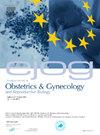Prediction of survival in fetuses with left-sided congenital diaphragmatic hernia: Which method is better using MRI observed to expected total fetal lung volumes?
IF 2.1
4区 医学
Q2 OBSTETRICS & GYNECOLOGY
European journal of obstetrics, gynecology, and reproductive biology
Pub Date : 2025-02-16
DOI:10.1016/j.ejogrb.2025.02.032
引用次数: 0
Abstract
Objective
The Observed to Expected Total Fetal Lung Volume (O/E-TFLV) ratio, calculated using fetal MRI, is a common method to assess pulmonary hypoplasia severity in congenital diaphragmatic hernia (CDH). However, its accuracy may be affected by uncertain gestational age (GA), inaccurate pregnancy dating, or abnormal fetal growth. This study aimed to evaluate whether GA determined by first-trimester dating or fetal size at imaging affects the ability of O/E-TFLV to predict 6-month survival in fetuses with isolated left-sided CDH.
Methods
Retrospective cohort study of fetuses with isolated left-sided CDH. O/E-TFLV was calculated using GA based on CRL (O/E-TFLVGA) or fetal size-determined GA (O/E-TFLVEFW) at the time of MRI. Prediction of survival was evaluated using ROC curves and logistic regression analyses adjusting by CDH severity and liver herniation.
Results
Ninety-seven fetuses underwent third-trimester MRI, with seventy-nine (81 %) also having second-trimester MRI. At six months, 80/97 (82.5 %) were alive. No significant differences were observed between O/E-TFLVGA and O/E-TFLVEFW during the second (31.5[2–74]% vs. 31.7[2.5–86]%, p = 0.71) or third trimester (33.6[0.1–134.3]% vs. 31.7[8–105]%, p = 0.55). Higher O/E-TFLVGA and higher O/E-TFLVEFW were associated with higher chances of survival (Second trimester: O/E-TFLVGA: Odds Ratio 1.09 [95 %CI: 1.02–1.20], p = 0.04; O/E-TFLVEFW: 1.10[1.01–1.20], p = 0.04; Third trimester: O/E-TFLVGA: 1.06[1.02–1.16], p = 0.04; O/E-TFLVEFW: 1.03[1.01–1.09], p = 0.04). No significant differences were found in predictive accuracy between O/E-TFLVGA and O/E-TFLVEFW based on Area Under the Curve (AUC) analysis (Second trimester: p = 0.65; Third trimester: p = 0.72).
Conclusion
There were no difference in the prediction of survival in isolated left-sided CDH fetuses using O/E-TFLV regardless of the method used to calculate O/E-TFLV.
求助全文
约1分钟内获得全文
求助全文
来源期刊
CiteScore
4.60
自引率
3.80%
发文量
898
审稿时长
8.3 weeks
期刊介绍:
The European Journal of Obstetrics & Gynecology and Reproductive Biology is the leading general clinical journal covering the continent. It publishes peer reviewed original research articles, as well as a wide range of news, book reviews, biographical, historical and educational articles and a lively correspondence section. Fields covered include obstetrics, prenatal diagnosis, maternal-fetal medicine, perinatology, general gynecology, gynecologic oncology, uro-gynecology, reproductive medicine, infertility, reproductive endocrinology, sexual medicine and reproductive ethics. The European Journal of Obstetrics & Gynecology and Reproductive Biology provides a forum for scientific and clinical professional communication in obstetrics and gynecology throughout Europe and the world.

 求助内容:
求助内容: 应助结果提醒方式:
应助结果提醒方式:


